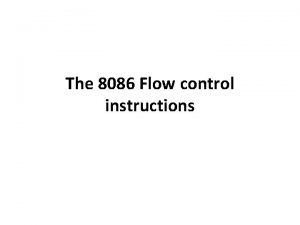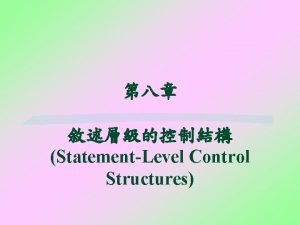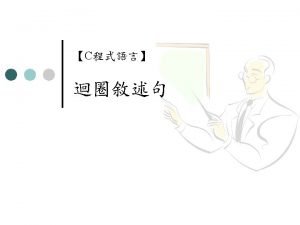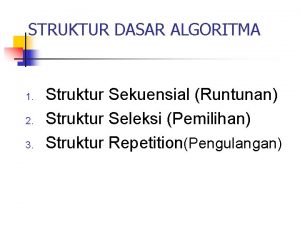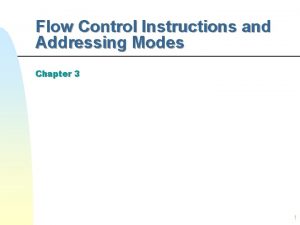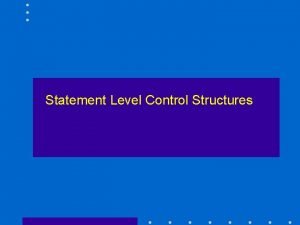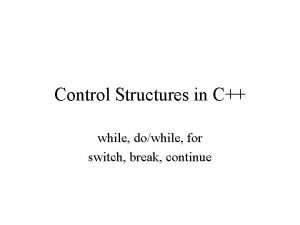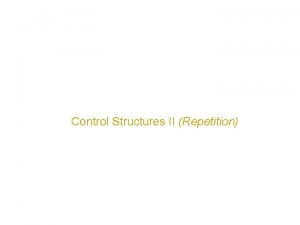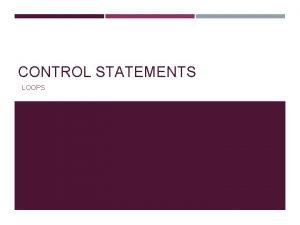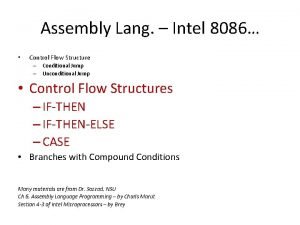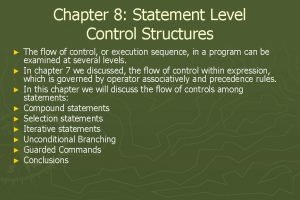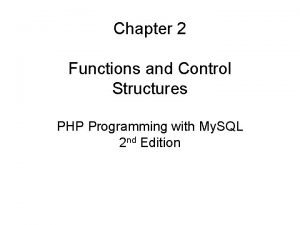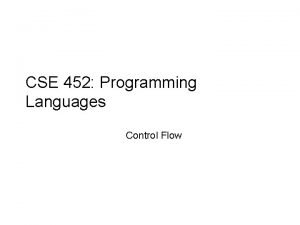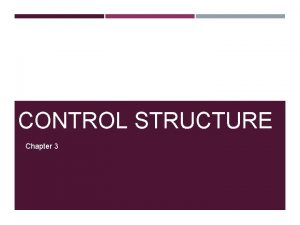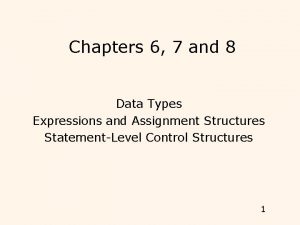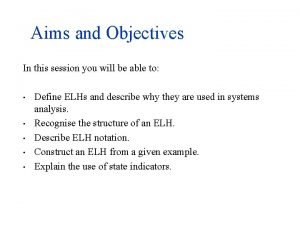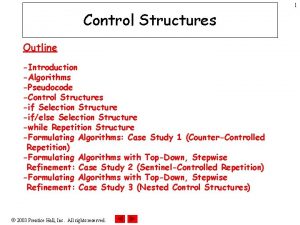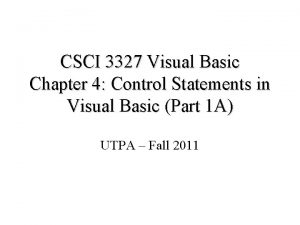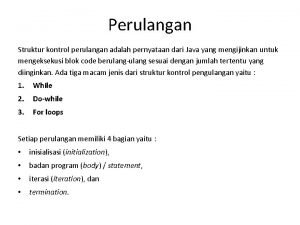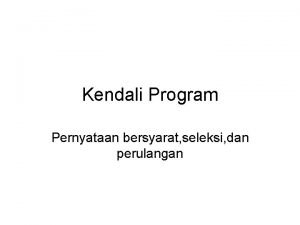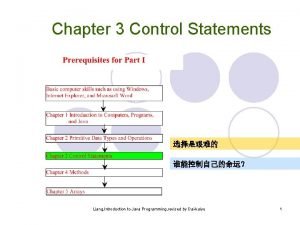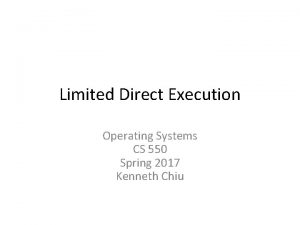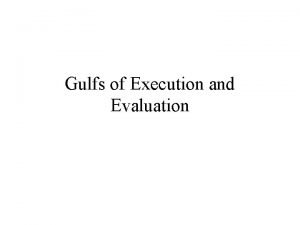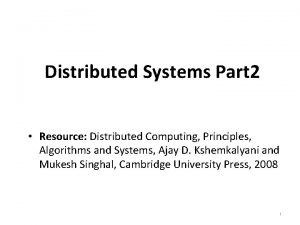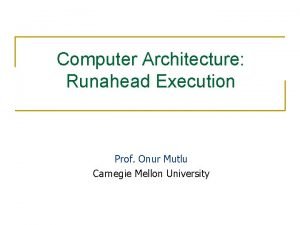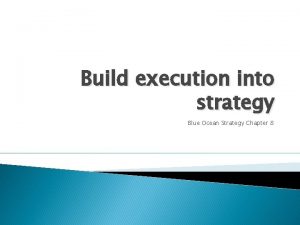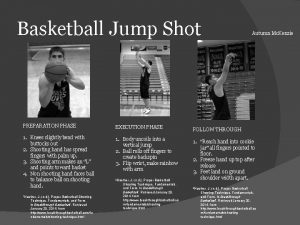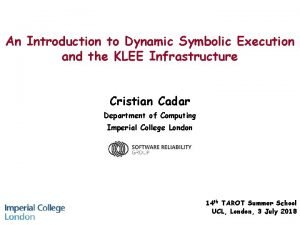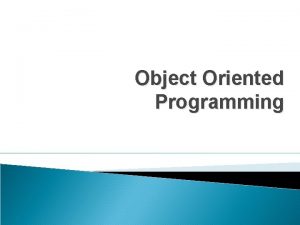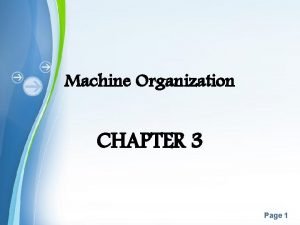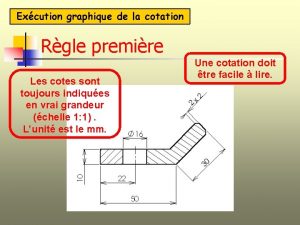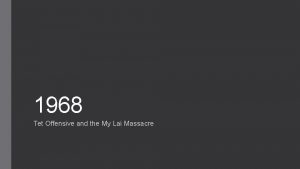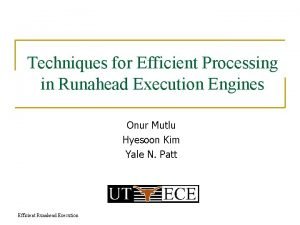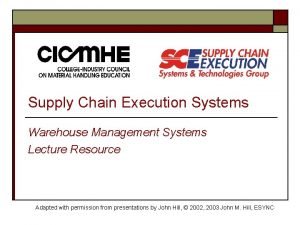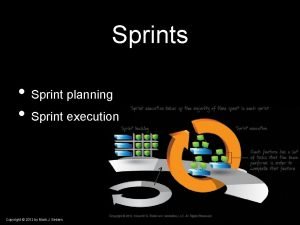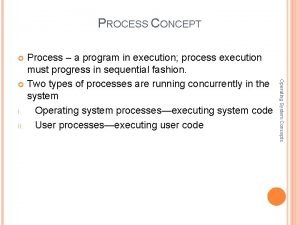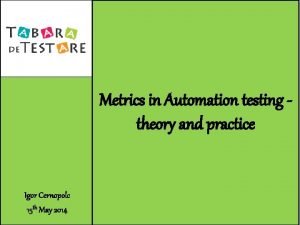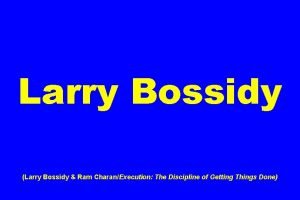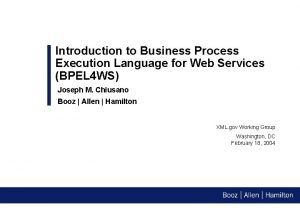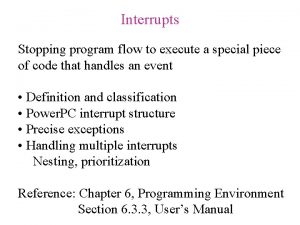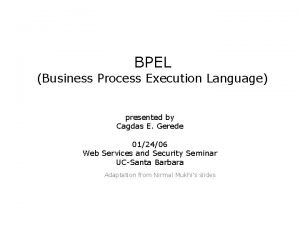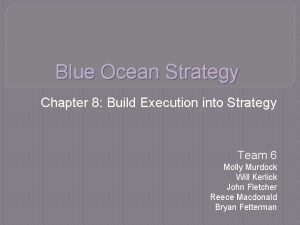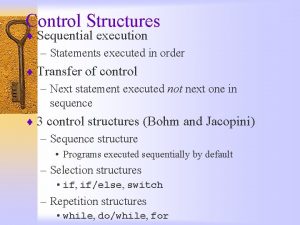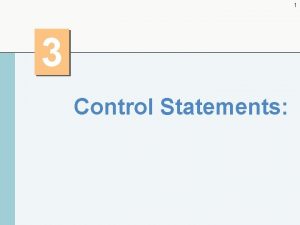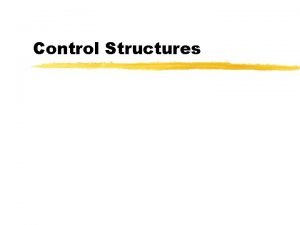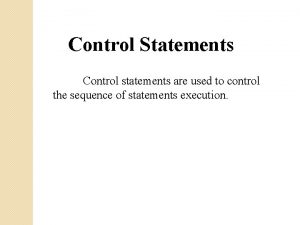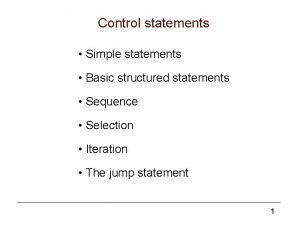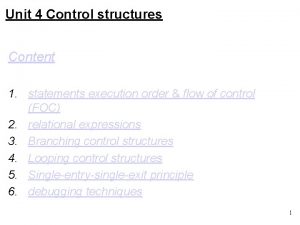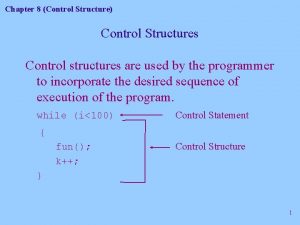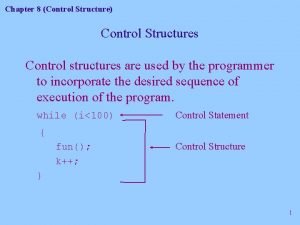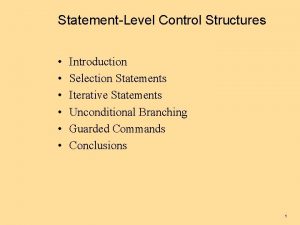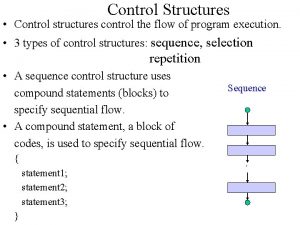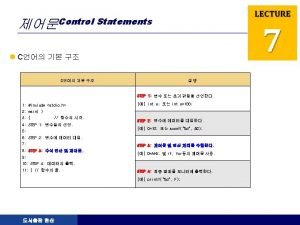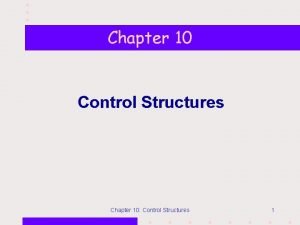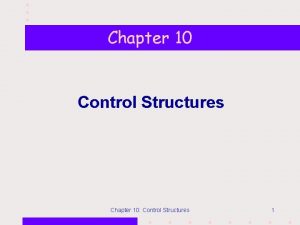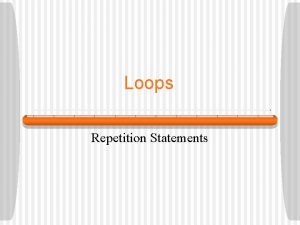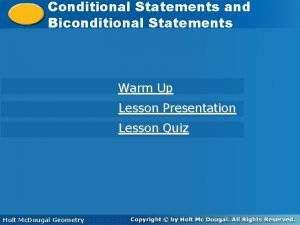1 Chapter 2 Control Structures Sequential execution Statements






































































- Slides: 70

1 Chapter 2 - Control Structures • Sequential execution – Statements executed in order • Transfer of control – Next statement executed not next one in sequence • 3 control structures (Bohm and Jacopini) – Sequence structure • Programs executed sequentially by default – Selection structures • if, if/else, switch – Repetition structures • while, do/while, for 2003 Prentice Hall, Inc. All rights reserved.

2. 1 Sequential programs Problem : Compute and print the summation of two numbers. #include <iostream. h> void main() { int a, b, s; cout<<"Please Enter two numbers: "; cin>>a>>b; s = a + b; cout<<"s="<<s<<endl; } 2003 Prentice Hall, Inc. All rights reserved. 2

3 Problem : Compute the area of the circle. Where area = R 2 π #include <iostream. h> void main() { const double Pi = 3. 14; int r; cout<<"n Please enter r"; cin>>r; double a; a = Pi * r; cout<<"n Circle's Area = "<<a<<endl; } 2003 Prentice Hall, Inc. All rights reserved.

4 • C++ keywords – Cannot be used as identifiers or variable names 2003 Prentice Hall, Inc. All rights reserved.

5 2. 2 if Selection Structure • Selection structure – Choose among alternative courses of action – If the condition is true • Print statement executed, program continues to next statement – If the condition is false • Print statement ignored, program continues – Indenting makes programs easier to read • C++ ignores whitespace characters (tabs, spaces, etc. ) 2003 Prentice Hall, Inc. All rights reserved.

6 2. 2 if Selection Structure • Translation into C++ If student’s grade is greater than or equal to 60 Print “Passed” if ( grade >= 60 ) cout << "Passed"; • if structure – Single-entry/single-exit 2003 Prentice Hall, Inc. All rights reserved.

7 2. 3 if/else Selection Structure • if – Performs action if condition true • if/else – Different actions if conditions true or false • C++ code if ( grade >= 60 ) cout << "Passed"; else cout << "Failed"; 2003 Prentice Hall, Inc. All rights reserved.

8 2. 3 if/else Selection Structure • Ternary conditional operator (? : ) – Three arguments (condition, value if true, value if false) • Code could be written: cout << ( grade >= 60 ? “Passed” : “Failed” ); Condition 2003 Prentice Hall, Inc. All rights reserved. Value if true Value if false

2. 3 if/else Selection Structure Nested if/else structures • Example if ( grade >= 90 ) cout << "A"; else if ( grade >= 80 ) cout << "B"; else if ( grade >= 70 ) cout << "C"; else if ( grade >= 60 ) cout << "D"; else cout << "F"; 2003 Prentice Hall, Inc. All rights reserved. // 90 and above // 80 -89 // 70 -79 // 60 -69 // less than 60 9

10 2. 3 if/else Selection Structure • Compound statement – Set of statements within a pair of braces if ( grade cout << else { cout << >= 60 ) "Passed. n"; "Failed. n"; "You must take this course again. n"; } – Without braces, cout << "You must take this course again. n"; always executed • Block – Set of statements within braces 2003 Prentice Hall, Inc. All rights reserved.

11 Another example if ( x>y) {if ( x<z) cout<<“ Hello”; } else cout<<“Hi”; 2003 Prentice Hall, Inc. All rights reserved.

12 2. 4 while Repetition Structure • Repetition structure – Action repeated while some condition remains true – while loop repeated until condition becomes false • Example int product = 2; while ( product <= 1000 ) product = 2 * product; 2003 Prentice Hall, Inc. All rights reserved.

13 • Counter-controlled repetition – Loop repeated until counter reaches certain value • Definite repetition – Number of repetitions known • Example A class of ten students took a quiz. The grades (integers in the range 0 to 100) for this quiz are available to you. Determine the class average on the quiz. 2003 Prentice Hall, Inc. All rights reserved.

1 2 3 // Fig. 2. 7: fig 02_07. cpp // Class average program with counter-controlled repetition. #include <iostream> 4 5 6 7 using std: : cout; using std: : cin; using std: : endl; 8 9 10 11 12 13 14 15 // function main begins int main() { int total; // int grade. Counter; // int grade; // int average; // 16 17 18 19 Outline program execution sum of grades input by user number of grade to be entered next grade value average of grades fig 02_07. cpp (1 of 2) // initialization phase total = 0; // initialize total grade. Counter = 1; // initialize loop counter 20 2003 Prentice Hall, Inc. All rights reserved. 14

21 22 23 24 25 26 27 // processing phase while ( grade. Counter <= 10 ) { cout << "Enter grade: "; cin >> grade; total = total + grade; grade. Counter = grade. Counter + 1; } 28 29 30 // termination phase average = total / 10; 31 32 33 // display result cout << "Class average is " << average << endl; 34 35 return 0; 36 37 // indicate } // end function main Enter grade: 98 Enter grade: 76 Enter grade: 71 Enter grade: 87 Enter grade: 83 Enter grade: 90 Enter grade: 57 // // // loop 10 times prompt for input read grade from user add grade to total increment counter Outline // integer division The counter gets incremented each time the loop executes. program ended successfully Eventually, the counter causes the loop to end. fig 02_07. cpp (2 of 2) fig 02_07. cpp output (1 of 1) 2003 Prentice Hall, Inc. All rights reserved. 15

16 2. 5 Assignment Operators • Assignment expression abbreviations – Addition assignment operator c = c + 3; abbreviated to c += 3; • Statements of the form variable = variable operator expression; can be rewritten as variable operator= expression; • Other assignment operators d e f g -= *= /= %= 4 5 3 9 2003 Prentice Hall, Inc. All rights reserved. (d (e (f (g = = d e f g * / % 4) 5) 3) 9)

17 2. 5 Increment and Decrement Operators • Increment operator (++) - can be used instead of c += 1 • Decrement operator (--) - can be used instead of c -= 1 – Preincrement • When the operator is used before the variable (++c or –c) • Variable is changed, then the expression it is in is evaluated. – Posincrement • When the operator is used after the variable (c++ or c--) • Expression the variable is in executes, then the variable is changed. 2003 Prentice Hall, Inc. All rights reserved.

18 2. 5 Increment and Decrement Operators • Increment operator (++) – Increment variable by one – c++ • Same as c += 1 • Decrement operator (--) similar – Decrement variable by one – c-- 2003 Prentice Hall, Inc. All rights reserved.

19 2. 5 Increment and Decrement Operators • Preincrement – Variable changed before used in expression • Operator before variable (++c or --c) • Postincrement – Incremented changed after expression • Operator after variable (c++, c--) 2003 Prentice Hall, Inc. All rights reserved.

20 2. 5 Increment and Decrement Operators • If c = 5, then – cout << ++c; • c is changed to 6, then printed out – cout << c++; • Prints out 5 (cout is executed before the increment. • c then becomes 6 2003 Prentice Hall, Inc. All rights reserved.

21 2. 5 Increment and Decrement Operators • When variable not in expression – Preincrementing and postincrementing have same effect ++c; cout << c; and c++; cout << c; are the same 2003 Prentice Hall, Inc. All rights reserved.

1 2 3 // Fig. 2. 14: fig 02_14. cpp // Preincrementing and postincrementing. #include <iostream> 4 5 6 using std: : cout; using std: : endl; 7 8 9 10 11 // function main begins program execution int main() { int c; // declare variable 12 13 14 15 16 17 // demonstrate postincrement c = 5; // cout << c << endl; // cout << c++ << endl; // cout << c << endl; // assign 5 to c print 5 then postincrement print 6 18 19 20 21 22 23 // demonstrate preincrement c = 5; // cout << c << endl; // cout << ++c << endl; // cout << c << endl; // assign 5 to c print 5 preincrement then print 6 Outline fig 02_14. cpp (1 of 2) 2003 Prentice Hall, Inc. All rights reserved. 22

24 25 26 27 5 5 6 6 return 0; // indicate successful termination Outline } // end function main fig 02_14. cpp (2 of 2) fig 02_14. cpp output (1 of 1) 2003 Prentice Hall, Inc. All rights reserved. 23

2. 6 Essentials of Counter-Controlled Repetition • Counter-controlled repetition requires – – Name of control variable/loop counter Initial value of control variable Condition to test for final value Increment/decrement to modify control variable when looping 2003 Prentice Hall, Inc. All rights reserved. 24

1 2 3 // Fig. 2. 16: fig 02_16. cpp // Counter-controlled repetition. #include <iostream> 4 5 6 using std: : cout; using std: : endl; 7 8 9 10 11 // function main begins program execution int main() { int counter = 1; // initialization 12 13 14 15 while ( counter <= 10 ) { cout << counter << endl; ++counter; 16 17 } // end while 18 19 return 0; 20 21 // repetition condition // display counter // increment Outline fig 02_16. cpp (1 of 1) // indicate successful termination } // end function main 2003 Prentice Hall, Inc. All rights reserved. 25

1 2 3 4 5 6 7 8 9 10 Outline fig 02_16. cpp output (1 of 1) 2003 Prentice Hall, Inc. All rights reserved. 26

27 Problem : Print the following numbers. 1 3 5 7 9 11 #include <iostream. h> void main() { int i=1; while (i <= 11) { cout<<i<<'t'; i+=2; } } Remark: Write ((i+=2) <= 11 ) condition instead of the above one. What changes you have to do to produce the same output. 2003 Prentice Hall, Inc. All rights reserved.

28 Problem : Read five numbers from the user and print the positive numbers only. #include <iostream. h> void main() { int num, j=0; while ( j++ < 5 ) { cout<<"Enter the next num: "; cin>>num; if (num > 0) cout<<num<<endl; } } 2003 Prentice Hall, Inc. All rights reserved.

29 Problem : Compute and Print the value of M where M = 2 * 4 * 6 * … * n #include <iostream. h> void main() { int N, M=1, i=2; cout<<"Enter the upper limit: "; cin>>N; while ( i <= N ) { M *= i; i += 2; } cout<<"n. M="<<M; } 2003 Prentice Hall, Inc. All rights reserved.

2. 6 Essentials of Counter-Controlled Repetition • The declaration int counter = 1; – – Names counter Declares counter to be an integer Reserves space for counter in memory Sets counter to an initial value of 1 2003 Prentice Hall, Inc. All rights reserved. 30

31 2. 7 for Repetition Structure • General format when using for loops for ( initialization; Loop. Continuation. Test; increment ) statement • Example for( int counter = 1; counter <= 10; counter++ ) cout << counter << endl; – Prints integers from one to ten No semicolon after last statement 2003 Prentice Hall, Inc. All rights reserved.

1 2 3 // Fig. 2. 17: fig 02_17. cpp // Counter-controlled repetition with the for structure. #include <iostream> 4 5 6 using std: : cout; using std: : endl; 7 8 9 10 11 12 // function main begins program execution int main() { // Initialization, repetition condition and incrementing // are all included in the for structure header. 13 14 15 for ( int counter = 1; counter <= 10; counter++ ) cout << counter << endl; 16 17 return 0; 18 19 Outline fig 02_17. cpp (1 of 1) // indicate successful termination } // end function main 2003 Prentice Hall, Inc. All rights reserved. 32

1 2 3 4 5 6 7 8 9 10 Outline fig 02_17. cpp output (1 of 1) 2003 Prentice Hall, Inc. All rights reserved. 33

34 Problem : Print the following numbers. 1 3 5 7 #include <iostream. h> void main( ) { for (int k=1; k<=11; k+=2) cout<<k<<“t”; cout<<endl; } 2003 Prentice Hall, Inc. All rights reserved. 9 11

35 Problem : Print the following numbers. 20 17 14 11 8 #include <iostream. h> void main() { for (int m=20; m>=2; m-=3) cout<<m<<“t”; cout<<endl; } 2003 Prentice Hall, Inc. All rights reserved. 5 2

36 Problem : Compute and print the summation of any 10 numbers entered by the user. #include <iostream. h> void main() { int S=0, N; for (int i=10; i>=1; i--) { cout<<"n. Please Enter the next number: "; cin>>N; S+=N; } cout<<"n. S="<<S<<endl; } 2003 Prentice Hall, Inc. All rights reserved.

37 Problem : Compute and Print the factorial of the number 5. (Fact = 5 * 4 * 3 * 2 * 1) #include <iostream. h> void main( ) { int Fact=1; for (int j=5; j>=1; j--) Fact *= j; cout<<"5!= "<<Fact<<endl; } 2003 Prentice Hall, Inc. All rights reserved.

38 • Note: for loops can usually be rewritten as while loops initialization; while ( loop. Continuation. Test){ statement increment; } • Initialization and increment – For multiple variables, use comma-separated lists for (int i = 0, j = 0; j + i <= 10; j++, i++) cout << j + i << endl; 2003 Prentice Hall, Inc. All rights reserved.

39 2. 8 switch Multiple-Selection Structure • switch – Test variable for multiple values – Series of case labels and optional default case switch ( variable ) { case value 1: statements break; case value 2: case value 3: statements break; default: statements break; // taken if variable == value 1 // necessary to exit switch // taken if variable == value 2 or == value 3 // taken if variable matches no other cases } 2003 Prentice Hall, Inc. All rights reserved.

40 2. 8 switch Multiple-Selection Structure 2003 Prentice Hall, Inc. All rights reserved.

41 switch examples Switch(grade) {case ‘A’: cout<<“The Grade is A”; break; case ‘B’: cout<<“The Grade is B”; break; case ‘C’: cout<<“The Grade is C”; break; case ‘D’: cout<<“The Grade is D”; break; case ‘F’: cout<<“The Grade is F”; break; Default: cout<< “The Grade is invalid”; } 2003 Prentice Hall, Inc. All rights reserved.

switch examples #include<iostream. h> int main() { int a; cout<<“ Enter an Integer between 0 and 10: “; cin>>a; cout<<“n. The number you entered is “<<a<<endl; switch(a) { case 0: case 1: cout<<“hello”; case 2: cout<<“there”; case 3: cout<<“I am”; case 4: cout<<“Mickey”<<endl; break; case 5: cout<<“How “; case 6: case 7: case 8: cout<<“are you “<<endl; break; case 9: break; case 10: cout<<“Have a nice day. “<<endl; break; default: cout<<“sorry, the number is out of range. ”<<endl; } cout<< “ out of switch structure. ”<<endl; return 0; 2003 Prentice Hall, Inc. All rights reserved. }//main 42

switch examples Switch(score/10) { case 0: case 1: case 2: case 3: case 4: case 5: grade = ‘F’; break; case 6: grade = ‘D’; break; case 7: grade = ‘C’; break; case 8: grade = ‘B’; break; case 9: case 10: grade = ‘A’; break; default: cout<<“Invalid test score. ”<<endl; } 2003 Prentice Hall, Inc. All rights reserved. 43

switch examples Switch (age>=18) { case 1: cout<<“old enough to be drafted. ”<<endl; cout<< “old enough to vote. ”<<endl; break; case 0: cout<<“Not old enough to be drafted. ”<<endl; cout<< “Not old enough to vote. ”<<endl; } 2003 Prentice Hall, Inc. All rights reserved. 44

45 2. 9 do/while Repetition Structure • Similar to while structure – Makes loop continuation test at end, not beginning – Loop body executes at least once • Format do { statement } while ( condition ); 2003 Prentice Hall, Inc. All rights reserved.

1 2 3 // Fig. 2. 24: fig 02_24. cpp // Using the do/while repetition structure. #include <iostream> 4 5 6 using std: : cout; using std: : endl; 7 8 9 10 11 // function main begins program execution int main() { int counter = 1; // initialize counter 12 13 14 15 do { cout << counter << " "; } while ( ++counter <= 10 ); 16 17 cout << endl; 18 19 return 0; 20 21 Notice the preincrement in loop-continuation test. // display counter // end do/while Outline fig 02_24. cpp (1 of 1) fig 02_24. cpp output (1 of 1) // indicate successful termination } // end function main 1 2 3 4 5 6 7 8 9 10 2003 Prentice Hall, Inc. All rights reserved. 46

47 2. 10 break and continue Statements • break statement – Immediate exit from while, for, do/while, switch – Program continues with first statement after structure • Common uses – Escape early from a loop – Skip the remainder of switch 2003 Prentice Hall, Inc. All rights reserved.

1 2 3 // Fig. 2. 26: fig 02_26. cpp // Using the break statement in a for structure. #include <iostream> 4 5 6 using std: : cout; using std: : endl; 7 8 9 10 // function main begins program execution int main() { 11 12 13 14 15 int x; // x declared here so it can be used after the loop // loop 10 times for ( x = 1; x <= 10; x++ ) { Exits for structure when break executed. 16 17 18 19 // if x is 5, terminate loop if ( x == 5 ) break; // break loop only if x is 5 20 21 cout << x << " "; Outline fig 02_26. cpp (1 of 2) // display value of x 22 23 } // end for 24 25 cout << "n. Broke out of loop when x became " << x << endl; 2003 Prentice Hall, Inc. All rights reserved. 48

26 27 28 29 return 0; // indicate successful termination Outline } // end function main 1 2 3 4 Broke out of loop when x became 5 fig 02_26. cpp (2 of 2) fig 02_26. cpp output (1 of 1) 2003 Prentice Hall, Inc. All rights reserved. 49

50 2. 10 break and continue Statements • continue statement – Used in while, for, do/while – Skips remainder of loop body – Proceeds with next iteration of loop • while and do/while structure – Loop-continuation test evaluated immediately after the continue statement • for structure – Increment expression executed – Next, loop-continuation test evaluated 2003 Prentice Hall, Inc. All rights reserved.

1 2 3 // Fig. 2. 27: fig 02_27. cpp // Using the continue statement in a for structure. #include <iostream> 4 5 6 using std: : cout; using std: : endl; 7 8 9 10 11 12 // function main begins program execution int main() { // loop 10 times for ( int x = 1; x <= 10; x++ ) { Skips to next iteration of the loop. next iteration of loop 13 14 15 16 // if x is 5, continue with if ( x == 5 ) continue; // skip remaining code in loop body 17 18 cout << x << " "; Outline fig 02_27. cpp (1 of 2) // display value of x 19 20 } // end for structure 21 22 23 cout << "n. Used continue to skip printing the value 5" << endl; 24 25 return 0; // indicate successful termination 2003 Prentice Hall, Inc. All rights reserved. 51

26 27 } // end function main Outline 1 2 3 4 6 7 8 9 10 Used continue to skip printing the value 5 fig 02_27. cpp (2 of 2) fig 02_27. cpp output (1 of 1) 2003 Prentice Hall, Inc. All rights reserved. 52

53 2. 11 Logical Operators • Used as conditions in loops, if statements • && (logical AND) – true if both conditions are true if ( gender == 1 && age >= 65 ) ++senior. Females; • || (logical OR) – true if either of condition is true if ( semester. Average >= 90 || final. Exam >= 90 ) cout << "Student grade is A" << endl; 2003 Prentice Hall, Inc. All rights reserved.

54 2. 11 Logical Operators • ! (logical NOT, logical negation) – Returns true when its condition is false, & vice versa if ( !( grade == sentinel. Value ) ) cout << "The next grade is " << grade << endl; Alternative: if ( grade != sentinel. Value ) cout << "The next grade is " << grade << endl; 2003 Prentice Hall, Inc. All rights reserved.

2. 12 Confusing Equality (==) and Assignment (=) Operators • Common error – Does not typically cause syntax errors • Aspects of problem – Expressions that have a value can be used for decision • Zero = false, nonzero = true – Assignment statements produce a value (the value to be assigned) 2003 Prentice Hall, Inc. All rights reserved. 55

2. 12 Confusing Equality (==) and Assignment (=) Operators • Example if ( pay. Code == 4 ) cout << "You get a bonus!" << endl; – If paycode is 4, bonus given • If == was replaced with = if ( pay. Code = 4 ) cout << "You get a bonus!" << endl; – Paycode set to 4 (no matter what it was before) – Statement is true (since 4 is non-zero) – Bonus given in every case 2003 Prentice Hall, Inc. All rights reserved. 56

2. 12 Confusing Equality (==) and Assignment (=) Operators • Lvalues – Expressions that can appear on left side of equation – Can be changed (I. e. , variables) • x = 4; • Rvalues – Only appear on right side of equation – Constants, such as numbers (i. e. cannot write 4 = x; ) • Lvalues can be used as rvalues, but not vice versa 2003 Prentice Hall, Inc. All rights reserved. 57

58 2. 13 Operator Precedence Operator Description ( ) parentheses +, – , ! unary plus, unary minus, Not Precedence Highest *, /, % + , - Binary plus, binary minus <, <=, >, >= == , != Equal, not equal && || = Assignment 2003 Prentice Hall, Inc. All rights reserved. Lowest

59 2. 13 Operator Precedence • Find the value of the following expression: (1) 5 + 8 * 2 / 4 16 4 9 (This is the final result) 2003 Prentice Hall, Inc. All rights reserved.

2. 13 Operator Precedence Find value of the following expression ( 9 + 3 ) - 6 / 3 + 5 12 2 10` 15 (this is the final result) 2003 Prentice Hall, Inc. All rights reserved. 60

2. 13 Operator Precedence Find the value of the following Expression If x = True, y = False, z = False, find the value of the expression x && y || z x && y || z False (the final result) 2003 Prentice Hall, Inc. All rights reserved. 61

2. 13 Operator Precedence • X=true, Y=false, Z= true X || Y && Z true • X=true, Y=false, Z= false X || Y && Z true 2003 Prentice Hall, Inc. All rights reserved. 62

2. 13 Operator Precedence Find the value of the following Expression If a = 3, b = 5, x = true, y = false, find the value of the expression: ( a < b ) AND y OR x ( a < b ) && y || x True False True (the final result) 2003 Prentice Hall, Inc. All rights reserved. 63

64 2. 13 Operator Precedence What is the output of the following code: #include <iostream. h> void main() { int a=10, b=3; cout<<"n a+b= t"<<a+b; cout<<"n a+b*2= t"<<a+b*2; cout<<"n (a+b)*2 t"<<(a+b)*2<<endl; cout<<a<<“<“<<b<<" ist"<<(a<b); cout<<"n a+b != a+3 is t"<<(a+b != a+3); cout<<"n a+b >= b*2 || a>b+9 is t"<<(a+b >= b*2 || a>b+9)<<endl; } 2003 Prentice Hall, Inc. All rights reserved.

2. 14 Nested Loops Nested for Print the following shape ***** ***** cin>>n; for(int i=1; i<=n; i++) { for (int j=1; j<=n; j++) cout<<“*”; cout<<endl; } 2003 Prentice Hall, Inc. All rights reserved. 65

66 Nested for Problem : Draw the following shape * ** ***** #include <iostream. h> void main( ) { for (int raw=1; raw<=5; raw++) { for (int C=1; C<=raw; C++) cout<<'*'; cout<<endl; } } 2003 Prentice Hall, Inc. All rights reserved.

Nested for Problem : display the multiplication table for the numbers from 1 to 5. 1 2 3 4 5 2 4 6 8 10 2003 Prentice Hall, Inc. All rights reserved. 3 6 9 12 15 4 8 12 16 20 5 10 15 20 25 67

Nested for (int i=1; i<=5; i++) { for(int j=1; j<=5; j++) cout<<i*j<<“t”; cout<<endl; } 2003 Prentice Hall, Inc. All rights reserved. 68

Nested for S=m 0 + m 1 + … +mn #include <iostream. h> void main() {int s=0, n, m; int t=1; cout<<"Enter m please "; cin>>m; cout<<"Enter n please "; cin>>n; for (int i=0; i<=n; i++) { t=1; for (int j=1; j<=i; j++) t=t*m; s=s+t; } cout<<s<<endl; } 2003 Prentice Hall, Inc. All rights reserved. 69

Nested While Problem : Draw the following shape * ** ***** #include <iostream. h> void main() { int i=1; while (i<=5) { int j=1; while (j<=i) { cout<<'*'; j++; } cout<<endl; i++; } } 2003 Prentice Hall, Inc. All rights reserved. 70
 Homologous
Homologous Cmp in microprocessor
Cmp in microprocessor Control flow graph java
Control flow graph java Sequence selection iteration
Sequence selection iteration Contoh algoritma sekuensial
Contoh algoritma sekuensial Sequential control flow instructions
Sequential control flow instructions Hardware and control structures
Hardware and control structures Statement level control structures
Statement level control structures Control structures in php
Control structures in php Control structures in c
Control structures in c Repetition structure in c++
Repetition structure in c++ Types of control structures
Types of control structures Loop in assembly language 8086
Loop in assembly language 8086 Statement level control structures
Statement level control structures Control structures in php
Control structures in php Iteration control structures
Iteration control structures Which is not a repetition control structure in java?
Which is not a repetition control structure in java? Iteration control structures
Iteration control structures Iteration control structures
Iteration control structures Repetition pseudocode example
Repetition pseudocode example Control structure in visual basic
Control structure in visual basic Perulangan java
Perulangan java Conditional control
Conditional control Control statements in java
Control statements in java The secret to successful strategy execution
The secret to successful strategy execution Execution defects
Execution defects Planning without execution is hallucination
Planning without execution is hallucination Direct and manage project execution
Direct and manage project execution Asp.net execution model
Asp.net execution model In this scheme cpu execution waits while i/o proceeds.
In this scheme cpu execution waits while i/o proceeds. Code execution ia-32 ia-64
Code execution ia-32 ia-64 Limited direct execution protocol
Limited direct execution protocol Gulf of execution and evaluation
Gulf of execution and evaluation Design fifo and non fifo execution
Design fifo and non fifo execution Runahead execution
Runahead execution Reference model of full virtualization
Reference model of full virtualization Recruiting and retaining capable employees does not entail
Recruiting and retaining capable employees does not entail My intuition is telling me there'll be better days
My intuition is telling me there'll be better days Btechsmartclass
Btechsmartclass Strategy formulation process
Strategy formulation process Who invented the jump shot
Who invented the jump shot Dynamic symbolic execution
Dynamic symbolic execution Portfolio selection
Portfolio selection Lexical issues in java with example
Lexical issues in java with example Microprocessor ppt template free download
Microprocessor ppt template free download Execution graphique de la cotation
Execution graphique de la cotation Eddie saigon
Eddie saigon Process and execution
Process and execution Project management chapter 4
Project management chapter 4 Cognitive hurdle
Cognitive hurdle Cognitive hurdle
Cognitive hurdle Advertising appeals
Advertising appeals Execution de saigon
Execution de saigon Yue minjun biography
Yue minjun biography Business process execution language for web services
Business process execution language for web services What are the 5 types of mark under voyage system.
What are the 5 types of mark under voyage system. Visualfactory
Visualfactory Runahead execution
Runahead execution Supply chain execution systems
Supply chain execution systems Sprint execution
Sprint execution A process is a program in execution
A process is a program in execution Automation testing metrics
Automation testing metrics D365 lean manufacturing
D365 lean manufacturing Larry bossidy and ram charan
Larry bossidy and ram charan Business process execution language for web services
Business process execution language for web services Interrupts execution flow
Interrupts execution flow Data transfer instructions in 8085 with example
Data transfer instructions in 8085 with example Contoh dokumen inisiasi proyek
Contoh dokumen inisiasi proyek His execution horrified much of europe
His execution horrified much of europe Business process execution language
Business process execution language Build execution into strategy
Build execution into strategy

